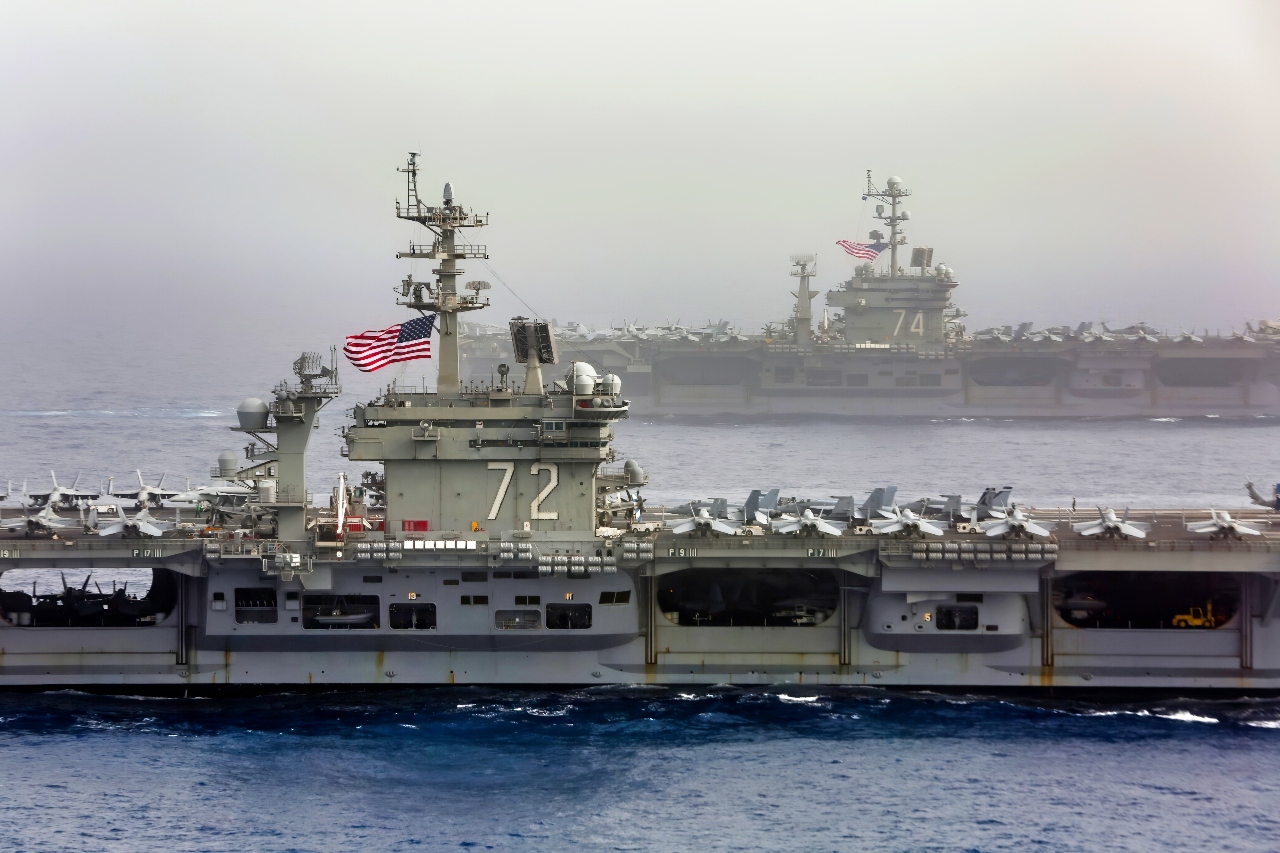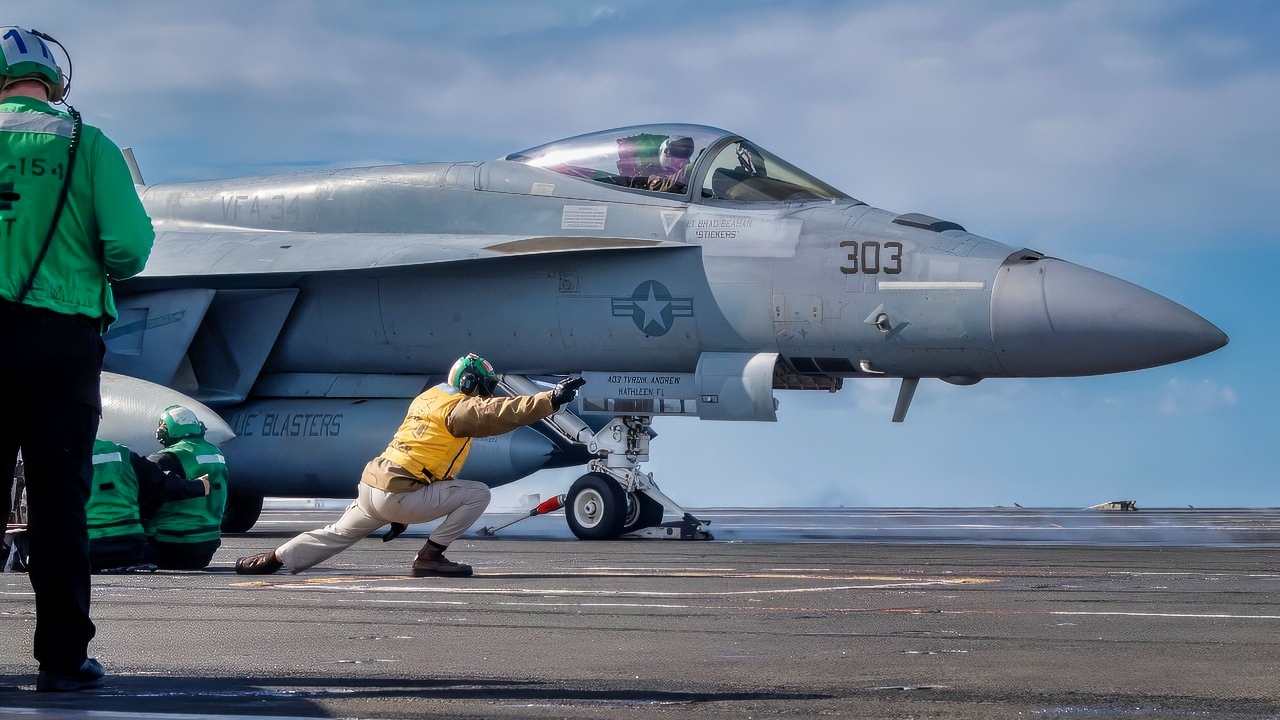Key Points and Summary – China’s anti-ship missiles (DF-21D/DF-26) sharpen the question: if aircraft carriers grow too vulnerable, what projects power?
-The likely answer isn’t a single ship but a mix—submarines (especially Virginia Block VI with the VPM boost), missile-heavy “arsenal” ships, long-range strike weapons, and swarms of unmanned systems and CCAs. Smaller flattops don’t solve survivability by themselves, and subs can’t provide organic airpower.

(April 24, 2019)
The Abraham Lincoln and John C. Stennis carrier strike groups conduct carrier strike force operations in the U.S. 6th Fleet. Together, the strike groups will complete high-end warfighting training, enhancing interoperability with key allies and partners in the European theater. (U.S. Navy video by Mass Communication Specialist 1st Class Brian M. Wilbur/Released)
-Politics also makes mothballing carriers unlikely.
-More plausible is a hybrid: aircraft carriers operating farther out with longer-range air wings (F-47/F/A-XX, hypersonics, MQ-25), while subs and arsenal ships deliver massed fires. The mission endures; the toolkit gets distributed.
If The Aircraft Carrier Is Obsolete, Then What Does The Navy Project Power With?
The United States’ biggest adversary, China, has been developing advanced fighters and long-range missile systems.
Much has been written that the US Navy needs a new platform capable of establishing air superiority and surviving in high-threat environments, while protecting the Navy’s biggest power projection platforms, its aircraft carriers.
Some analysts suggest that the carrier’s age may be nearing its end. Does the War Department view the aircraft carrier as an increasingly obsolete power-projection platform due to the threat of China’s newest and longer-range missiles? They have a much better range and accuracy than before.

U.S. Navy Lt. Andrew Bentley signals an F/A-18E Super Hornet, assigned to the “Blue Blasters” of Strike Fighter Squadron (VFA) 34, to launch from the flight deck of the Nimitz-class aircraft carrier USS Theodore Roosevelt (CVN 71), Nov. 30, 2023. Theodore Roosevelt, the flagship of Carrier Strike Group Nine (CSG 9), is conducting integrated training exercises in the U.S. 3rd Fleet area of operations. (U.S. Navy photo by Mass Communication Specialist 3rd Class Adina Phebus)
If the carrier’s days are truly numbered, what then becomes the US Navy’s ship or ships of power projection?
China’s A2/AD Systems
China’s strategy seems to be that, rather than engaging in combat with US carriers one-on-one, they will attempt to remove them from the equation entirely by engaging them from maximum distance.
China’s land-based DF-21D ‘carrier killer’ ballistic missile with 1000+ miles range—makes it possible to attack aircraft carriers over great distances at reduced or no risk. China has also developed the DF-26B missile that can reach US bases in Guam.
That could be one reason why the Pentagon is loath to develop two new advanced fighters at the same time, the F-47, which has priority, over the Navy’s F/A-XX.
China Believes In Aircraft Carriers
China, however, doesn’t view the carrier as obsolete, given the production rate of new carrier development and construction. China has built a dense anti-access/area denial (A2/AD) envelope to protect its fleet and homeland from US strikes.
China is also advancing its own naval aviation. The introduction of the J-35 stealth carrier fighter and the KJ-600 airborne early warning aircraft strengthens China’s ability to contest sea and air control.
Possible Alternatives To The Aircraft Carrier
The US operates 11 aircraft carriers as well as nine amphibious assault ships (LHDs), which are used to maintain force projection around the globe. However, the US carriers may struggle to approach their targets without incurring unacceptably large volumes of enemy fire due to the aforementioned Chinese missiles.

Ford-Class Aircraft Carrier. Image Credit: Creative Commons.
Among the Pentagon’s carrier critics, the F/A-XX might seem like a Band-Aid fix for an obsolete platform. So what are the Navy’s alternatives?
First, in many possible conflicts around the globe, many potential enemies don’t have near the A2/D2 capabilities that China possesses, so the carrier would still have an important role for decades to come. So the airline itself is an option to keep. But for this article’s sake …
The Navy would likely replace the aircraft carrier with a diversified fleet of unmanned systems, missile-heavy “Arsenal Ships,” and strategically deployed smaller, less expensive “flattop” vessels, rather than a single, like-for-like replacement.
Smaller Flattops, Amphibious Assault Ships? Same Issues
This shift would move away from the vulnerable supercarrier model, incorporating advancements like autonomous drones and long-range missiles to provide global airpower projection and strike capabilities.
I don’t understand the smaller “flattop” amphibious assault ship scenario, because they are just as vulnerable as supercarriers, arguably even more so due to the smaller number of missiles protecting them.
Submarines Are A Great Alternative, Except For One Glaring Problem
I am a firm believer in building a fleet of Virginia-class Block VI submarines, which are a significant upgrade to the US Navy’s submarine fleet, incorporating advancements in stealth, sonar, and payload capacity. Regardless of whether the Navy keeps the carriers or not, this is a must.
These submarines are designed to support anti-submarine warfare, surface ship warfare, special operations, and land-attack missions. The Block VI introduces the Virginia Payload Module (VPM), which enhances Tomahawk missile capacity and flexibility.

(Feb. 25, 2019) The aircraft carrier USS John C. Stennis (CVN 74) transits the South China Sea at sunset, Feb. 25, 2019. The John C. Stennis Carrier Strike Group is deployed to the U.S. 7th Fleet area of operations in support of security and stability in the Indo-Pacific region. (U.S. Navy photo by Mass Communication Specialist 1st Class Ryan D. McLearnon/Released)
The module is 84 feet long — bringing the total length of the Virginia-class subs up from 377 feet to 461 feet, the Navy file said — and can store and launch payloads with diameters larger than the 21-inch diameter of a torpedo or Tomahawk missile. This will increase the Virginia-class boats’ Tomahawk missile capacity from 12 to 40.
Having a large fleet of the Virginia Block VI submarines would be an absolute must for the Navy, but the entire point of the submarine is for no one to see it. And, it carries no airpower for power projection.
Would Congress Ever Agree To Moth-Balling Aircraft Carriers?
This one could be tough. Partisan politics aside. Remember, Congress doesn’t always act correctly. Do we need to revisit the short-sighted decisions regarding the F-22, Seawolf, etc.?
Smaller, faster, and more maneuverable surface ships are an alternative as well, regardless of the carrier question. These, obviously, would be a much harder target to destroy. But again, the loss of all of that combined airpower would be significant.
However, many naval officers believe carriers today are even more survivable than in the Cold War. This particular article is several years old, but with the addition of US hypersonic weapons, the F-47, and possibly the F/A-XX, the War Department faces several difficult questions in the near future.
As I wrote about the main battle tanks, the face of war is changing. And the US must adapt, improvise, and overcome if it is to win a future conflict. Will that require getting rid of the aircraft carrier?
About the Author: Steve Balestrieri
Steve Balestrieri is a National Security Columnist. He served as a US Army Special Forces NCO and Warrant Officer. In addition to writing on defense, he covers the NFL for PatsFans.com and is a member of the Pro Football Writers of America (PFWA). His work was regularly featured in many military publications.
More Military
How the B-21 Raider and F-47 Could Be Obsolete
F-22 Raptor vs. Israel’s F-35I Adir: Who Wins?
Dassault Rafale Fighters Just Sent to Russia’s ‘Backyard’
F-15EX Eagle II vs. Su-57 Felon: Who Wins?
The Boeing X-32B Stealth Fighter Deserves a Better Fate Than This










